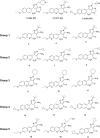5-Aminopyrazole-4-Carboxamide-Based Compounds Prevent the Growth of Cryptosporidium parvum
- PMID: 28533246
- PMCID: PMC5527629
- DOI: 10.1128/AAC.00020-17
5-Aminopyrazole-4-Carboxamide-Based Compounds Prevent the Growth of Cryptosporidium parvum
Abstract
Cryptosporidium parvum calcium-dependent protein kinase 1 (CpCDPK1) is a promising target for drug development against cryptosporidiosis. We report a series of low-nanomolar CpCDPK1 5-aminopyrazole-4-carboxamide (AC) scaffold inhibitors that also potently inhibit C. parvum growth in vitro Correlation between anti-CpCDPK1 and C. parvum growth inhibition, as previously reported for pyrazolopyrimidines, was not apparent. Nonetheless, lead AC compounds exhibited a substantial reduction of parasite burden in the neonatal mouse cryptosporidiosis model when dosed at 25 mg/kg.
Keywords: 5-aminopyrazole-4-carboxamide; Cryptosporidium parvum; bumped kinase inhibitors.
Copyright © 2017 American Society for Microbiology.
Figures


Similar articles
-
A novel calcium-dependent protein kinase inhibitor as a lead compound for treating cryptosporidiosis.J Infect Dis. 2013 Oct 15;208(8):1342-8. doi: 10.1093/infdis/jit327. Epub 2013 Jul 21. J Infect Dis. 2013. PMID: 23878324 Free PMC article.
-
Inhibition of Calcium-Dependent Protein Kinase 1 (CDPK1) In Vitro by Pyrazolopyrimidine Derivatives Does Not Correlate with Sensitivity of Cryptosporidium parvum Growth in Cell Culture.Antimicrob Agents Chemother. 2015 Nov 9;60(1):570-9. doi: 10.1128/AAC.01915-15. Print 2016 Jan. Antimicrob Agents Chemother. 2015. PMID: 26552986 Free PMC article.
-
Pyridopyrimidinones as a new chemotype of calcium dependent protein kinase 1 (CDPK1) inhibitors for Cryptosporidium.Mol Biochem Parasitol. 2024 Dec;260:111637. doi: 10.1016/j.molbiopara.2024.111637. Epub 2024 Jun 18. Mol Biochem Parasitol. 2024. PMID: 38901801
-
Cryptic parasite revealed improved prospects for treatment and control of human cryptosporidiosis through advanced technologies.Adv Parasitol. 2011;77:141-73. doi: 10.1016/B978-0-12-391429-3.00007-1. Adv Parasitol. 2011. PMID: 22137584 Review.
-
Cryptosporidiosis Drug Discovery: Opportunities and Challenges.ACS Infect Dis. 2016 Aug 12;2(8):530-7. doi: 10.1021/acsinfecdis.6b00094. Epub 2016 Jul 22. ACS Infect Dis. 2016. PMID: 27626293 Review.
Cited by
-
Comparison of Toxicities among Different Bumped Kinase Inhibitor Analogs for Treatment of Cryptosporidiosis.Antimicrob Agents Chemother. 2023 Apr 18;67(4):e0142522. doi: 10.1128/aac.01425-22. Epub 2023 Mar 15. Antimicrob Agents Chemother. 2023. PMID: 36920244 Free PMC article.
-
Structure-activity relationship of BMS906024 derivatives for Cryptosporidium parvum growth inhibition.Bioorg Med Chem Lett. 2023 Jun 15;90:129328. doi: 10.1016/j.bmcl.2023.129328. Epub 2023 May 15. Bioorg Med Chem Lett. 2023. PMID: 37196868 Free PMC article.
-
7 H-Pyrrolo[2,3- d]pyrimidin-4-amine-Based Inhibitors of Calcium-Dependent Protein Kinase 1 Have Distinct Inhibitory and Oral Pharmacokinetic Characteristics Compared with 1 H-Pyrazolo[3,4- d]pyrimidin-4-amine-Based Inhibitors.ACS Infect Dis. 2018 Apr 13;4(4):516-522. doi: 10.1021/acsinfecdis.7b00224. Epub 2018 Mar 16. ACS Infect Dis. 2018. PMID: 29522315 Free PMC article.
-
Identification of potent and orally efficacious phosphodiesterase inhibitors in Cryptosporidium parvum-infected immunocompromised male mice.Nat Commun. 2024 Sep 27;15(1):8272. doi: 10.1038/s41467-024-52658-y. Nat Commun. 2024. PMID: 39333545 Free PMC article.
-
Comparative Characterization of CpCDPK1 and CpCDPK9, Two Potential Drug Targets Against Cryptosporidiosis.Microorganisms. 2022 Feb 1;10(2):333. doi: 10.3390/microorganisms10020333. Microorganisms. 2022. PMID: 35208789 Free PMC article.
References
-
- Checkley W, White AC Jr, Jaganath D, Arrowood MJ, Chalmers RM, Chen XM, Fayer R, Griffiths JK, Guerrant RL, Hedstrom L, Huston CD, Kotloff KL, Kang G, Mead JR, Miller M, Petri WA Jr, Priest JW, Roos DS, Striepen B, Thompson RC, Ward HD, Van Voorhis WA, Xiao L, Zhu G, Houpt ER. 2015. A review of the global burden, novel diagnostics, therapeutics, and vaccine targets for cryptosporidium. Lancet Infect Dis 15:85–94. doi:10.1016/S1473-3099(14)70772-8. - DOI - PMC - PubMed
-
- White AC. 2015. Cryptosporidium species. In Bennett JE, Dolin R, Blaser MJ (ed), Mandell, Douglas, and Bennett's principles and practice of infectious diseases, 8th ed Elsevier/Saunders, Philadelphia, PA.
-
- Kotloff KL, Nataro JP, Blackwelder WC, Nasrin D, Farag TH, Panchalingam S, Wu Y, Sow SO, Sur D, Breiman RF, Faruque AS, Zaidi AK, Saha D, Alonso PL, Tamboura B, Sanogo D, Onwuchekwa U, Manna B, Ramamurthy T, Kanungo S, Ochieng JB, Omore R, Oundo JO, Hossain A, Das SK, Ahmed S, Qureshi S, Quadri F, Adegbola RA, Antonio M, Hossain MJ, Akinsola A, Mandomando I, Nhampossa T, Acácio S, Biswas K, O'Reilly CE, Mintz ED, Berkeley LY, Muhsen K, Sommerfelt H, Robins-Browne RM, Levine MM. 2013. Burden and aetiology of diarrhoeal disease in infants and young children in developing countries (the Global Enteric Multicenter Study, GEMS): a prospective, case-control study. Lancet 382:209–222. doi:10.1016/S0140-6736(13)60844-2. - DOI - PubMed
Publication types
MeSH terms
Substances
Grants and funding
LinkOut - more resources
Full Text Sources
Other Literature Sources
Medical

